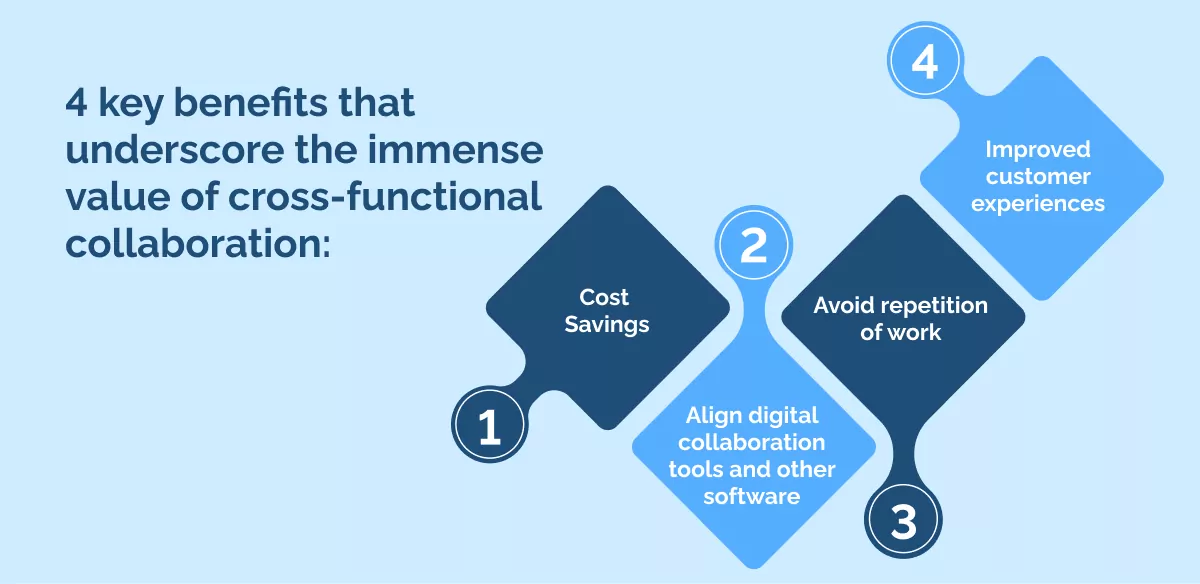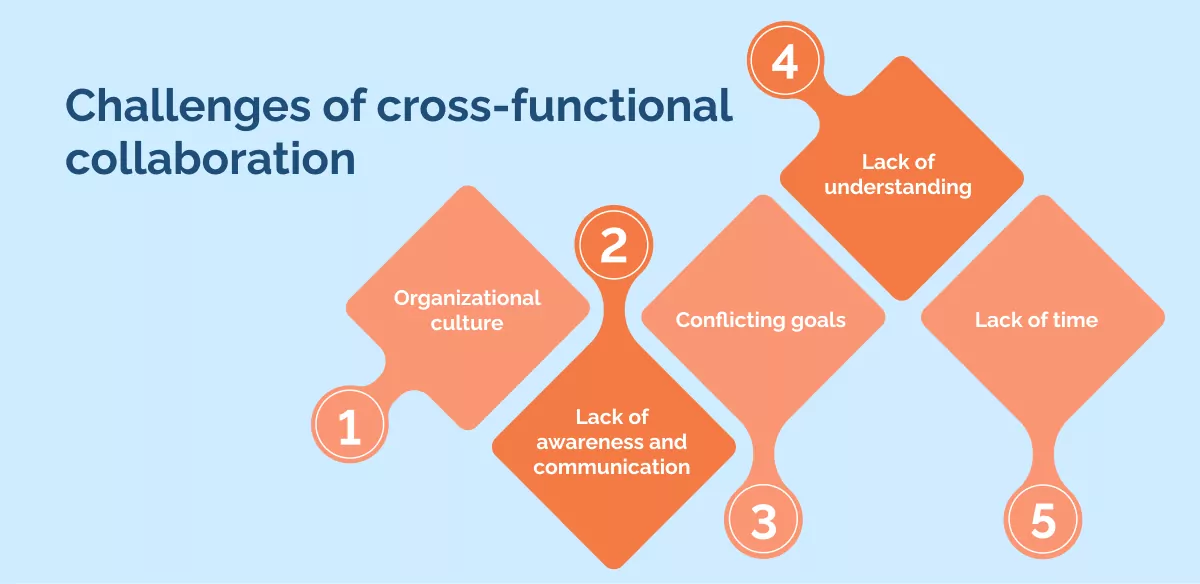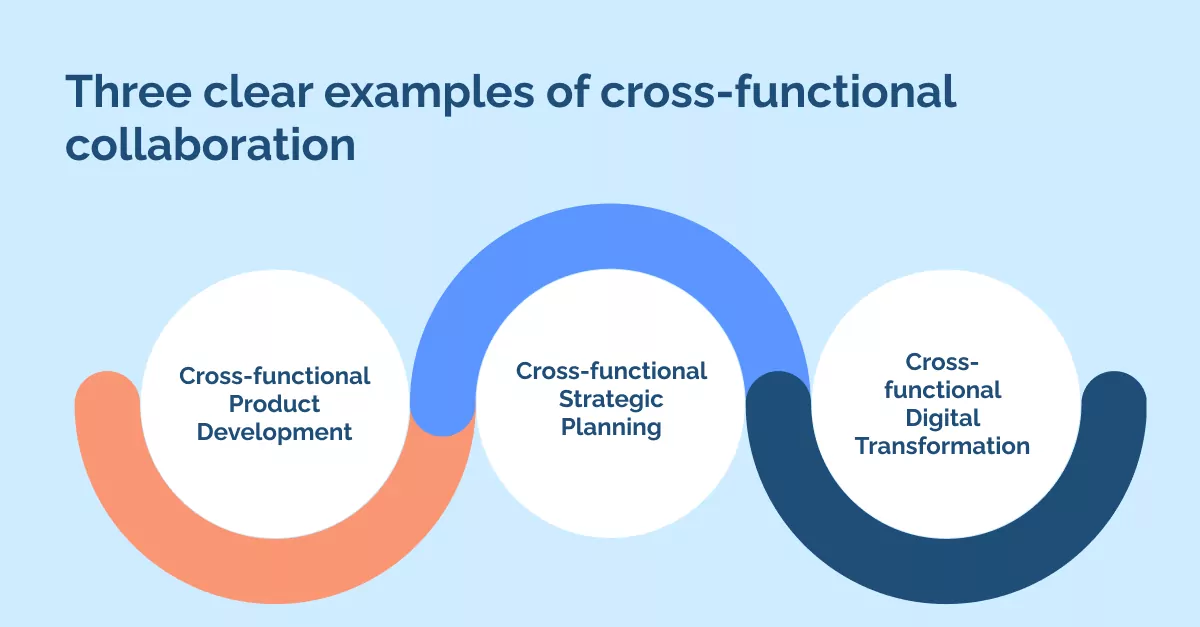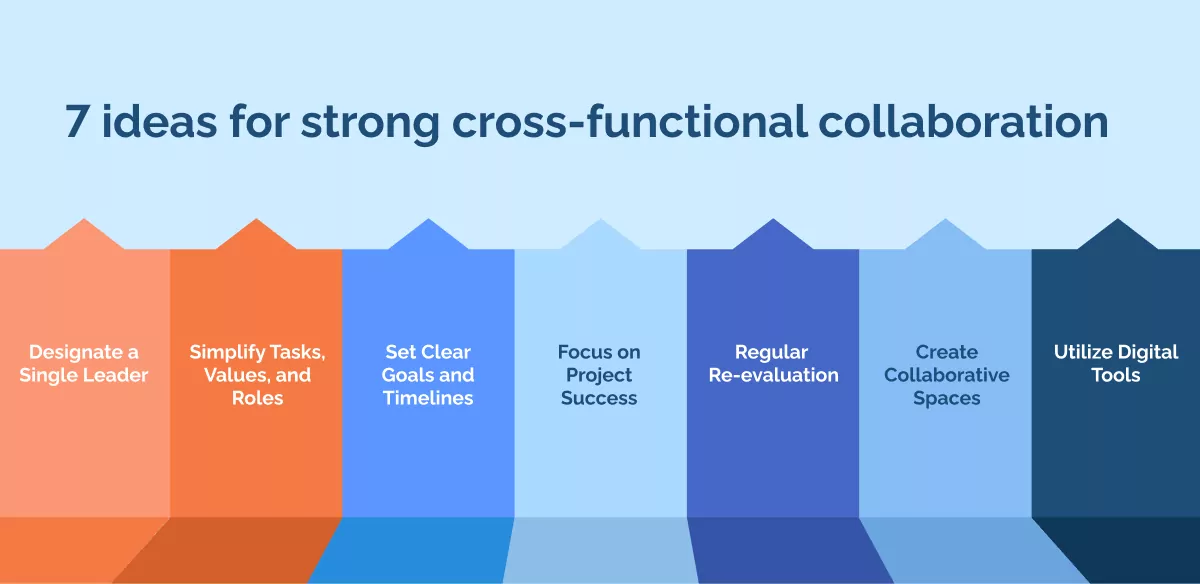
Cross-functional collaboration is an integral part of any thriving organization.
It’s a process where individuals from various departments or areas of expertise come together to work towards achieving a common goal. The beauty of this approach lies in its diversity – each member brings a unique perspective and set of skills, fostering a fertile ground for innovation and creative problem-solving.
This type of collaboration is not just about accomplishing tasks. It promotes open communication and breaks down silos within an organization. When cross functional teams collaborate, they share knowledge and insights that may otherwise remain confined within departmental boundaries.
Imagine going to a music festival where four bands are playing. In one band, every member is playing the drums. In another, everyone is playing guitar. In another, everyone is singing. But band number four does something different. They put a drummer, guitarist, and singer together in one group.
Which band is the best?
Perhaps all of them are doing something good. But there’s a chance that the last band will be the most interesting. Each member has a completely different set of skills. And with a shared purpose, they come together to achieve a common goal.
That’s exactly what cross-functional collaboration does. Cross-functional teams organize experts from across a company to do something unique and beautiful.
This article will give you a nice introduction to the key elements of cross-functional collaboration.
We will:
- Introduce the meaning, benefits, and challenges of cross-functional collaboration;
- Examine three key use case examples of cross-functional collaboration in action;
- Discuss some strategies managers can complete to support effective cross-functional collaboration.
In today’s digital workplace, we’ve got all the technology we need to make sure that collaboration happens. But bringing your collaboration efforts together takes a long planning process. Let’s take a look and see how you can make it happen.
What is cross-functional collaboration?
Cross-functional collaboration happens when people from different departments work together to achieve a common goal, solve complex problems, or improve processes.
A cross-functional team brings together individuals from various departments who may not typically interact with each other under normal circumstances. This collaboration allows for a more integrated approach to working, fostering communication and cooperation among team members.
In cross-functional collaboration, these teams break down silos, develop innovative ideas, and create positive outcomes.
The most common words describing this behavior are “cross-functional collaboration” or “cross-functional team.” However, people may use many other terms for this practice, such as “interdepartmental teamwork,” “interdisciplinary cooperation,” “multi-departmental collaboration, or “multidisciplinary collaboration.”
In your organization, perhaps managers have invented some crazy terms for their cross-functional teams. How about “holistic synergistic interdepartmental engagement,” “integrated organizational symbiosis,” or “cross-pollinating functional fusion“?
Don’t be fooled. Such names all mean the same thing.
Benefits of cross-functional collaboration
For many tasks, cross-functional collaboration can lead to positive and surprising results. Whether it’s embarking on a unique project or addressing day-to-day responsibilities, the advantages are profound and far-reaching.
Here are four key benefits that underscore the immense value of cross-functional collaboration:
- Cost Savings. A revealing Gartner study from 2021 showed that cross-functional collaboration and effective cost reduction are closely connected. Organizations can streamline their processes and allocate resources more efficiently by breaking down departmental barriers and fostering cooperation. This not only reduces unnecessary expenses but also enhances overall financial resilience.
- Align digital collaboration tools and other software. With cross-functional collaboration, large sections of an organization can run on a unified digital infrastructure. This alignment not only optimizes budget allocation but also facilitates seamless workflow integration. In other words, cross-functional teams can reduce the problems associated with the sprawling digital ecosystems of today’s workplaces.
- Avoid repetition of work. When teams operate in isolated silos, the risk of redundant efforts looms large. Cross-functional collaboration mitigates this concern by promoting a “do it once, do it effectively” ethos. As teams unite their efforts, they create a shared understanding of tasks and workflows, reducing the likelihood of repeating work.
- Improved customer experiences. In customer-facing roles, cross-functional collaboration yields a remarkable advantage. Teams with diverse perspectives and skill sets come together to provide a holistic and responsive approach to customer interactions. This results in an elevated standard of customer experience, boosting satisfaction and loyalty. By transcending departmental boundaries, businesses streamline operations and enrich the overall customer journey.
Challenges of cross-functional collaboration
Let’s face it: cross-functional collaboration can be quite challenging.
In a path-breaking 2015 article in HBR, Behnam Tabrizi revealed that up to 75% of cross-functional teams do not work effectively. So, when planning your cross-functional project, you’d better prepare for some of the difficulties.
The challenges of actually working in a cross-functional team:
- Organizational culture. Staff may have a deeply embedded silo mentality, meaning they may struggle to understand how to share with non-experts. Communicating is a challenge.
- Lack of awareness and communication. Cross-functional collaboration does not always come naturally. At the start, team members may not fully grasp the potential benefits and how to effectively collaborate across departments.
- Conflicting goals. Each department may have its own set of objectives and priorities. In cross-functional collaboration, the team members must align with the overarching organizational strategy.
- Lack of understanding. Successfully implementing cross-functional collaboration requires a shared understanding of roles, responsibilities, and processes among teams, and the absence of such clarity can impede progress and cause confusion.
- Lack of time. Time constraints pose a significant challenge, as team members are often already occupied with their core responsibilities, making it difficult to allocate the necessary time and resources for collaborative efforts that may seem secondary.
In addition to these practical issues with implementing cross-functional teams, business challenges may include keeping to a budget, deadline, or project goals.
If you have clear management, it’s easier for such problems to arise.
Three clear examples of cross-functional collaboration
Cross-functional collaboration is not always necessary. However, it’s especially valuable in key business situations like product development, strategic planning, and digital transformations.
In this section, we will explain why.
Cross-functional Product Development
While developing a new product or service, multiple functions within a company, such as research and development, marketing, design, manufacturing, and quality assurance, need to work together.
Cross-functional collaboration ensures that the product meets customer needs, is manufacturable, can be effectively marketed, and complies with quality standards.
This collaboration can streamline the development process and lead to a more successful product launch.
Cross-functional Strategic Planning
Cross-functional collaboration is essential when a company is formulating its strategic plans and goals.
Various departments, including finance, marketing, operations, and human resources, must work together to align their efforts with the overall strategy.
This ensures that the company’s resources, budgets, and personnel are allocated appropriately to achieve the desired outcomes.
Cross-functional Digital Transformation
In today’s digital age, businesses often need to undergo digital transformation efforts to stay competitive.
Cross-functional collaboration is key in this context as IT, marketing, operations, and other departments must coordinate to adopt new technologies, update processes, and enhance customer experiences.
This collaboration helps organizations leverage technology effectively and respond to the changing digital landscape.
Seven ideas for strong cross-functional collaboration
We’ve shown that cross-functional teams take some work to bring together effectively.
But when it’s done right, the results are impressive. Here are seven ideas to help your cross-functional collaborations thrive:
- Designate a Single Leader: Appointing a single leader for the cross-functional collaboration team provides clear direction and accountability. This leader can facilitate communication, make decisions, and ensure the team stays on track.
- Simplify Tasks, Values, and Roles: Keep tasks, values, and roles as straightforward as possible to minimize confusion and foster clarity within the team. Clear statements and definitions make it easier for team members to understand their responsibilities.
- Set Clear Goals and Timelines: Establish well-defined goals and timelines for the collaborative effort. While no single department may have sole accountability, a shared purpose and direction are essential for keeping everyone aligned.
- Focus on Project Success: The primary objective should always be the project’s success. All team members should be committed to this overarching goal, putting aside departmental or individual agendas.
- Regular Re-evaluation: Adopt an agile approach that involves continuous re-evaluation of progress, goals, and processes. This allows the team to adapt and refine its strategy to overcome challenges and seize opportunities.
- Create Collaborative Spaces: Physical spaces for cross-functional collaboration are essential, much like the need for hybrid working teams to have a place to meet and communicate. These spaces foster face-to-face interactions and idea-sharing.
- Utilize Digital Tools: Incorporate digital systems such as workplace planning software, project management tools, and other digital collaboration platforms. These tools streamline communication, project management, and document sharing, enhancing the efficiency of cross-functional teams.
Start building your cross-functional teams today
Cross-functional projects are not just important; they’re pivotal in the modern business environment. Their significance is rapidly escalating, and all indications suggest this trend will continue unabated.
A key metric that underscores the growing importance of cross-team collaboration is the anticipated growth in the market for collaborative software. According to Statista’s 2022 projections, the global sales of these tools could balloon to a staggering $20.8 billion by 2026. This exponential increase signifies the rising demand for platforms facilitating efficient and effective interaction between diverse teams.
However, the benefits of cross-functional projects extend beyond mere financial gains. They serve as a catalyst for fostering employee engagement. When personnel from various departments come together through these initiatives, it promotes a sense of unity and shared purpose. They break down silos, encourage the exchange of ideas, and create a vibrant, inclusive culture where everyone feels valued and heard.
Cross-functional projects are not just a business trend but a strategic necessity that fosters engagement, drives innovation, and accelerates the achievement of corporate goals.
WalkMe Team
WalkMe spearheaded the Digital Adoption Platform (DAP) for associations to use the maximum capacity of their advanced resources. Utilizing man-made consciousness, AI, and context-oriented direction, WalkMe adds a powerful UI layer to raise the computerized proficiency, everything being equal.







